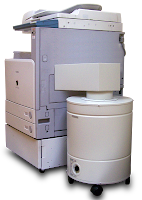 |
| Companies need to keep workers' health and safety in mind - or they may face costly litigation. |
The widow of a man who recently died of lung cancer has filed a lawsuit against the company that employed him for exposing him to asbestos.
According to an article in The Record in April, Katherine Jackson filed a lawsuit in St. Clair County Circuit Court against Illinois Central Railroad, alleging that the exposure caused her deceased husband’s fatal condition.
Jackson alleges her recently deceased husband, Claudy Jackson, worked as a fireman for the railroad company from 1948 until 1951.
During that time, Claudy Jackson was exposed to asbestos, diesel exhaust, environmental tobacco smoke, silica, welding fumes, toxic dusts, gases and other fumes, according to the complaint.
As a result of his exposure, Claudy Jackson experienced great pain, disability, mental anguish and nervousness and incurred medical costs, the suit states, and on April 26, 2008, Claudy Jackson died after a battle against lung cancer.
His wife claims the company did not follow proper health and safety procedures and is seeking a judgment of more than $200,000, plus costs.
Source: The Record
The dangers of asbestos exposure
The WHO identifies asbestos as one of the most dangerous occupational carcinogens, declaring the need to eliminate asbestos use and associated health damages. An estimated 107,000 people worldwide die from asbestos-related diseases.
Asbestos is a mineral fiber commonly used for insulation in constructions. It is relatively affordable, which makes it attractive in developing countries.
Asbestos-related lung diseases, particularly mesothelioma, lung cancer and asbestosis (asbestos induced lung fibrosis), typically develop after decades of lag time from first exposure.
Protect workers' health and safety with powerful air cleaners
Air purifiers and major air filtration systems from Electrocorp designed for mold and asbestos abatement projects can help keep the indoor air clean by removing chemicals, particles, fibers and gases from the air with a large activated carbon filter and a HEPA filter.
Electrocorp's air cleaners use only safe and proven filtration technologies. Contact Electrocorp for more information.
Related posts
Electrocorp's air cleaners use only safe and proven filtration technologies. Contact Electrocorp for more information.
Related posts
- Asbestos and radon among hidden dangers for renovation contractors and workers
- Asbestos lawsuits awards $322 million to man with asbestosis
- Asbestos: The hidden health hazard in many homes
- Asbestos lawsuit results in $9 million for former employee
- Avoid release of toxic substances during home energy retrofits, experts urge




















